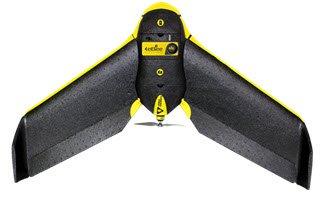Unmanned Aerial Vehicle (UAV) Frequently Asked Questions
What is a UAV?
A UAV is an unmanned aerial vehicle that is piloted by remote control or onboard computers.
Why did the City of Yellowknife purchase a UAV?
The City purchased a small fixed wing airplane-style UAV as a cost effective way to take aerial photos of Yellowknife. Previously, the City had to hire southern contractors to fly over the areas of interest and capture and process the data. Due to the significant costs associated with this approach, data could only be collected infrequently. However, the UAV has significantly less overhead, meaning data can be obtained in a much more timely and economical manner.
How are the photos used at the City?
Air photos provide a unique perspective that gives City staff additional information on which to base recommendations. Planning, engineering, assessment, mapping, and solid waste management are just some of the functions that currently rely on existing photos and will benefit from the availability of the up-to-date, project-specific imagery that can be captured by the UAV.
What does Yellowknife's UAV look like?
The City purchased a SenseFly eBee professional mapping drone. It has a built-in Sony WX 18 Megapixel Camera. The camera does not have thermal imaging, infrared, or zoom functions. The eBee weighs 690g and is made primarily of foam. At 18 km/hour the eBee has an impact force of 8.75 Joules; by comparison, the impact force of a Frisbee is 15.8 Joules and a football is 45 Joules.
What does Yellowknife's UAV sound like?
The UAV has a small battery operated engine that sounds like a swarm of bees and operates at about 75 decibels on the ground - about the same as standard vacuum cleaner in the next room. The UAV flies at an elevation of 100m (300ft) and at this distance it is very quiet - about the sound of a single bumble bee.

Is the City certified to fly in Yellowknife?
Users of UAVs above 250 grams, used within the City limits are required, by law, to obtain an Advanced Operations Pilot Certificate . This certificate must be acquired from the Transport Canada in advance of any flight of the UAV. Each flight plan will also be filed as with NAV Canada prior to any flight.
What training did the City receive to fly the UAVs?
Safety is the primary concern when flying UAVs within the City and all rules regulations will be adhered to. Yellowknife staff members have been trained in the operation of the UAV and all associated safety procedures and precautions by Carto Canada, Spatial Technologies and Arctic Response Canada.
Where will the City be flying?
Initial flights will take place over City-owned land, but will expand to new neighbourhoods and other areas where City initiatives are taking place. Before any flights on private land, permission will obtained from the landowner.
Can you see in my backyard?
No. Privacy is a high priority to the City and this initiative will in no way compromise that. The UAV will fly at about 30 kilometers per hour, approximately 100 meters above ground. It has no hover capabilities and its camera does not have a zoom lens, so photos will capture broad imagery, not detailed pictures. As an extra precaution, all footage will be reviewed to ensure citizen privacy.
Here is an example of the sample photo collected by the UAV from 100 metres above the ground.
How does the City notify the public of upcoming flights?
Prior to any flight, the City will file a NOTAM (Notice to Airmen) and obtain approval from NAV Canada. These NOTAMs are published on Nav Canada's web page (navcanada.ca).


